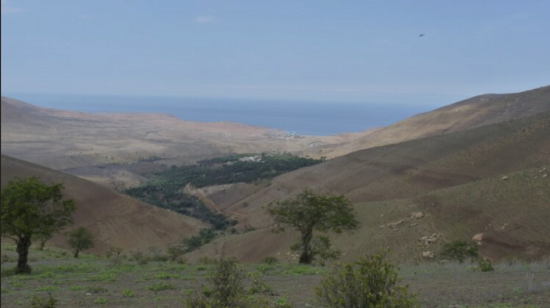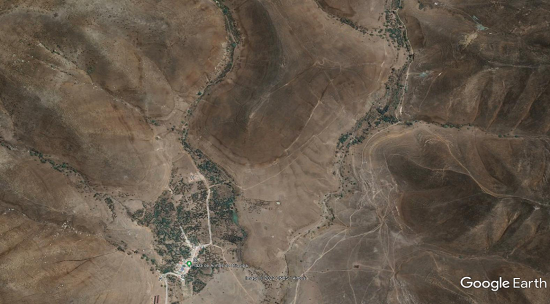The inception of APFNet’s first project in South America
October 20, 2022 (Thursday), 8:30-11:00 AM Beijing time
The inception workshop of APFNet’s first demonstration project in South America, Peru, called “Rehabilitation of Arid Ecosystems and Barren Lands through Agroforestry Systems in the Southern Coast of Peru [2022P1-PER]” was held online on Oct 20th, 2022. With total funding of USD 520,294, of which APFNet is funding USD 348,540, the project will run for 24 months from October 2022 to September 2024. The project aims to develop an agroforestry system in degraded and barren lands to improve the livelihoods of poor rural families and mitigate negative climate change effects in the provinces of Chala, Camana and La Joya in the department (the first-level administrative sub-division) of Arequipa and the province of Locumba in the department of Moquegua.
A total of 18 people attended the online event, including participants from APFNet, the Supervisory Agency National Forest and Wildlife Service (SERFOR) Peru, the Executing Agency Costa Verde, the Implementing Agency Fundacion Para El Desarrollo Agrario (FDA), and beneficiaries of the Atiquipa and Pampa Sitana farm association. During the inception workshop, information about the project background, project goals and objectives, and the first-year project annual work plan were discussed.
Rehabilitating Barren Lands through Agroforestry
The total land area of Peru is 128.5 million hectares with 78 million hectares of forests. Peru's forests are mainly tropical rainforests and semi-humid forests, however, the economy is also home to many arid and semi-arid forests that, if disturbed, are easily degraded. As such, despite abundant natural resources, there are more than 10 million hectares of degraded land in Peru. While most of the degraded land is located inland and only 0.6 million hectares at the coast, more than 60% of the economy’s population lives in this region. Therefore, prioritizing the rehabilitation of these degraded lands into healthy and productive areas through the use of livelihood-friendly systems, such as agroforestry, become imperative. A continuation of local degradation through unsustainable use may put at risk whole ecosystems, species, and people’s quality of life while increasing the pressure on nearby landscapes.

With this in mind, the APFNet project will contribute towards the rehabilitation of degraded ecosystems and rehabilitation of barren land in exactly this area. The lomas and arid zone in the experimental sites are susceptible to climate change due to their formation relying on the moist dense fog and mist from the Pacific. Therefore, in this project, APFNet assists the establishment of site-adapted species and supports the installation of drip irrigation systems and water catchment meshes, which may reduce the negative impacts of climate change.
Additionally, the combination of establishing sustainable, locally adapted agroforestry sites and strategically connecting local stakeholders and partners in production and value chains will substantially contribute to the rejuvenation of the local economy. Such a network is currently not in place, as only rather small and isolated production systems exist trying to benefit from arid and degraded ecosystems.
Key project activities will be based on developing small-scale agroforestry production systems, while engaging local communities and local governments in close collaboration and coordination with regional governments and national institutions like SERFOR. These agroforestry systems will rely on species that have proven effective for ecosystem services rehabilitation, as well as being adaptable to the extremely arid conditions on the sites. This specifically translates into the following 4 key outputs:
1. Establishment 20 pilot units of 5 ha each (a total of 100 ha) for conservation, reforestation, and agroforestry plots in degraded lands
2. Design of a value chain from the cultivation of the agroforestry products to final products ready for consumption
3. Establishment of a small experimental unit for value-adding to the non-timber forest products
4. Elaboration of a project proposal to scale up for the rehabilitation of degraded ecosystems and barren lands based on the models demonstrated in this project.

The inception workshop of APFNet’s first demonstration project in South America, Peru, called “Rehabilitation of Arid Ecosystems and Barren Lands through Agroforestry Systems in the Southern Coast of Peru [2022P1-PER]” was held online on Oct 20th, 2022. With total funding of USD 520,294, of which APFNet is funding USD 348,540, the project will run for 24 months from October 2022 to September 2024. The project aims to develop an agroforestry system in degraded and barren lands to improve the livelihoods of poor rural families and mitigate negative climate change effects in the provinces of Chala, Camana and La Joya in the department (the first-level administrative sub-division) of Arequipa and the province of Locumba in the department of Moquegua.
A total of 18 people attended the online event, including participants from APFNet, the Supervisory Agency National Forest and Wildlife Service (SERFOR) Peru, the Executing Agency Costa Verde, the Implementing Agency Fundacion Para El Desarrollo Agrario (FDA), and beneficiaries of the Atiquipa and Pampa Sitana farm association. During the inception workshop, information about the project background, project goals and objectives, and the first-year project annual work plan were discussed.
Rehabilitating Barren Lands through Agroforestry
The total land area of Peru is 128.5 million hectares with 78 million hectares of forests. Peru's forests are mainly tropical rainforests and semi-humid forests, however, the economy is also home to many arid and semi-arid forests that, if disturbed, are easily degraded. As such, despite abundant natural resources, there are more than 10 million hectares of degraded land in Peru. While most of the degraded land is located inland and only 0.6 million hectares at the coast, more than 60% of the economy’s population lives in this region. Therefore, prioritizing the rehabilitation of these degraded lands into healthy and productive areas through the use of livelihood-friendly systems, such as agroforestry, become imperative. A continuation of local degradation through unsustainable use may put at risk whole ecosystems, species, and people’s quality of life while increasing the pressure on nearby landscapes.

A typical degraded coastal landscape in Peru. Photo: Costa Verde

Deforestation of lomas project sites in 2022 due to fuel collection and cattle grazing in local communities. Photo: Google Earth 2022
Additionally, Peru has made commitments to the 20x20 Initiative in 2014 to restore and rehabilitate a total of 3.2 million hectares of degraded land, comprising 2 million hectares for reforestation and 1.2 million hectares for rehabilitation in the coastal, Andean (highlands) and Amazon (rainforest) regions. In this context, APFNet’s support of this project contributes towards the restoration goals for degraded lands in Peru. Also, APFNet’s core strategic objectives, which promote restoration activities related to climate change, food, energy security and clean development, are reflected in the project activities.
Deforestation of lomas project sites in 2022 due to fuel collection and cattle grazing in local communities. Photo: Google Earth 2022
With this in mind, the APFNet project will contribute towards the rehabilitation of degraded ecosystems and rehabilitation of barren land in exactly this area. The lomas and arid zone in the experimental sites are susceptible to climate change due to their formation relying on the moist dense fog and mist from the Pacific. Therefore, in this project, APFNet assists the establishment of site-adapted species and supports the installation of drip irrigation systems and water catchment meshes, which may reduce the negative impacts of climate change.
Additionally, the combination of establishing sustainable, locally adapted agroforestry sites and strategically connecting local stakeholders and partners in production and value chains will substantially contribute to the rejuvenation of the local economy. Such a network is currently not in place, as only rather small and isolated production systems exist trying to benefit from arid and degraded ecosystems.
Key project activities will be based on developing small-scale agroforestry production systems, while engaging local communities and local governments in close collaboration and coordination with regional governments and national institutions like SERFOR. These agroforestry systems will rely on species that have proven effective for ecosystem services rehabilitation, as well as being adaptable to the extremely arid conditions on the sites. This specifically translates into the following 4 key outputs:
1. Establishment 20 pilot units of 5 ha each (a total of 100 ha) for conservation, reforestation, and agroforestry plots in degraded lands
2. Design of a value chain from the cultivation of the agroforestry products to final products ready for consumption
3. Establishment of a small experimental unit for value-adding to the non-timber forest products
4. Elaboration of a project proposal to scale up for the rehabilitation of degraded ecosystems and barren lands based on the models demonstrated in this project.

Terrain preparation and drip irrigation system instalment at project sites. Photo: Jorge Malleux/COSTA VERDE NGO
Especially the last output is based on the vision that this project may introduce a new region-wide practice for the sustainable rehabilitation of the coastal region of Peru. If successful, the current barren lands may soon be transformed into green, lush mountains.


